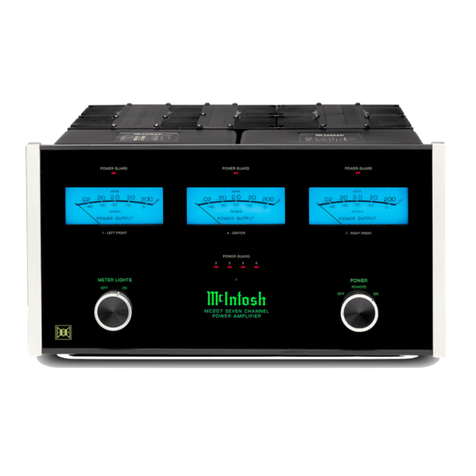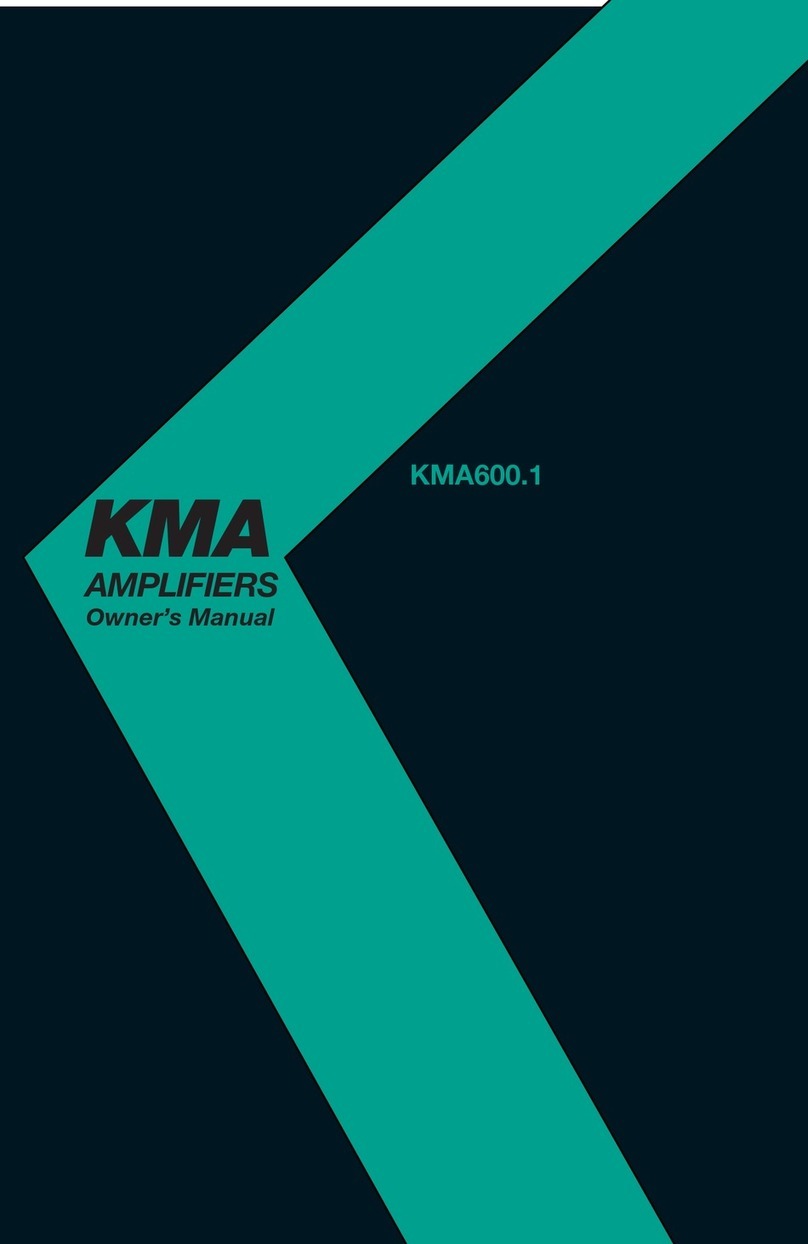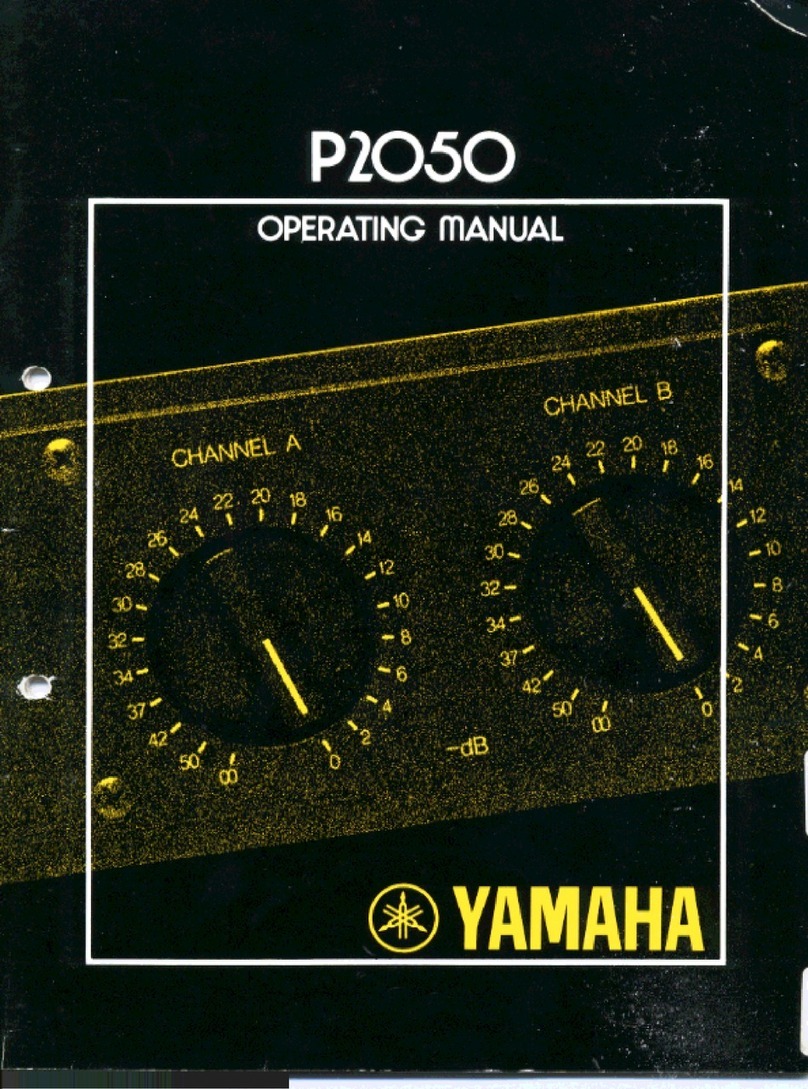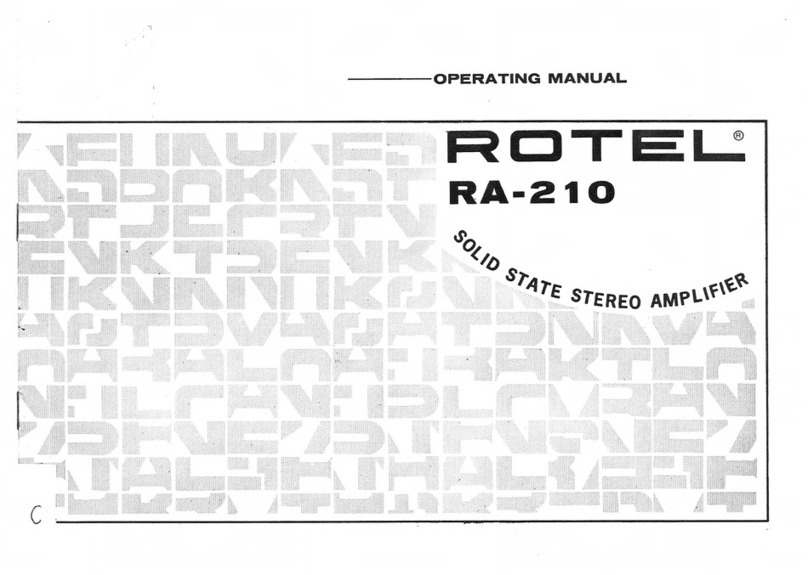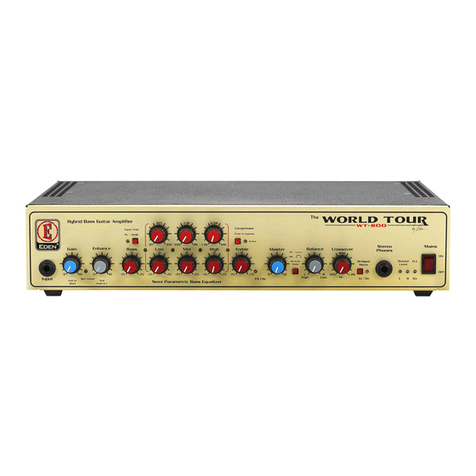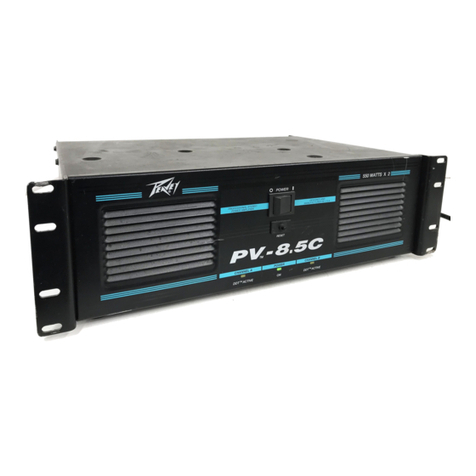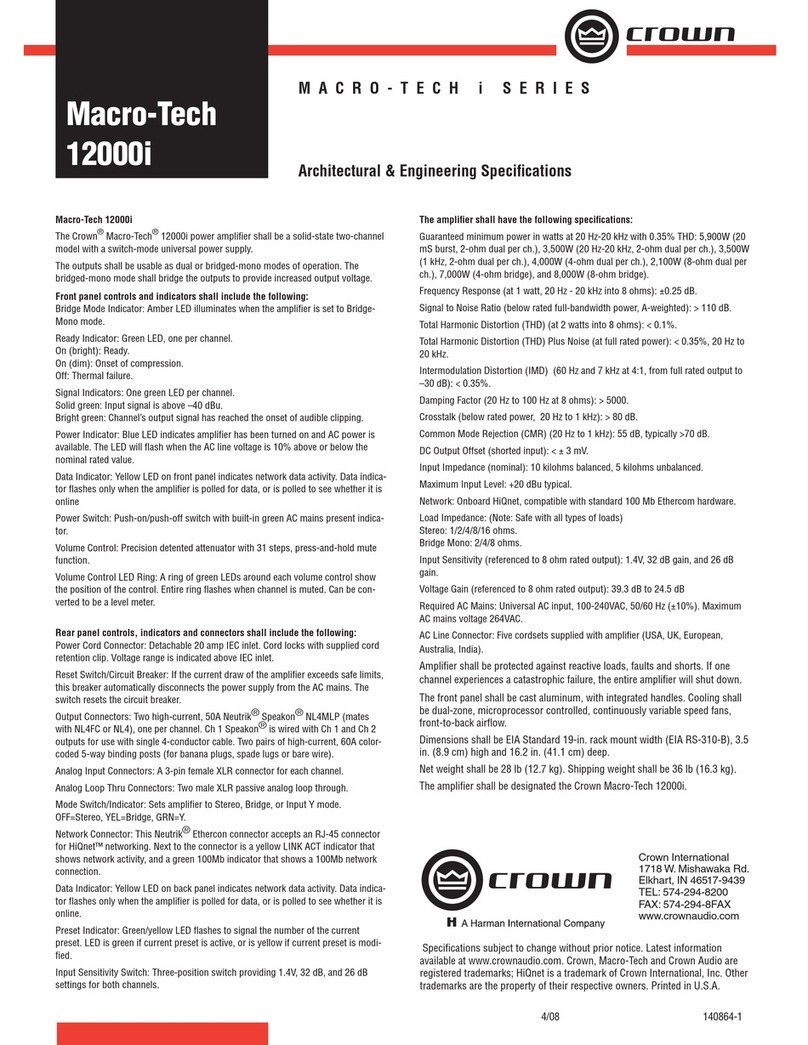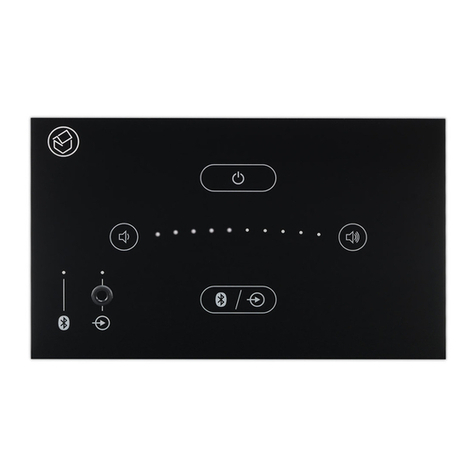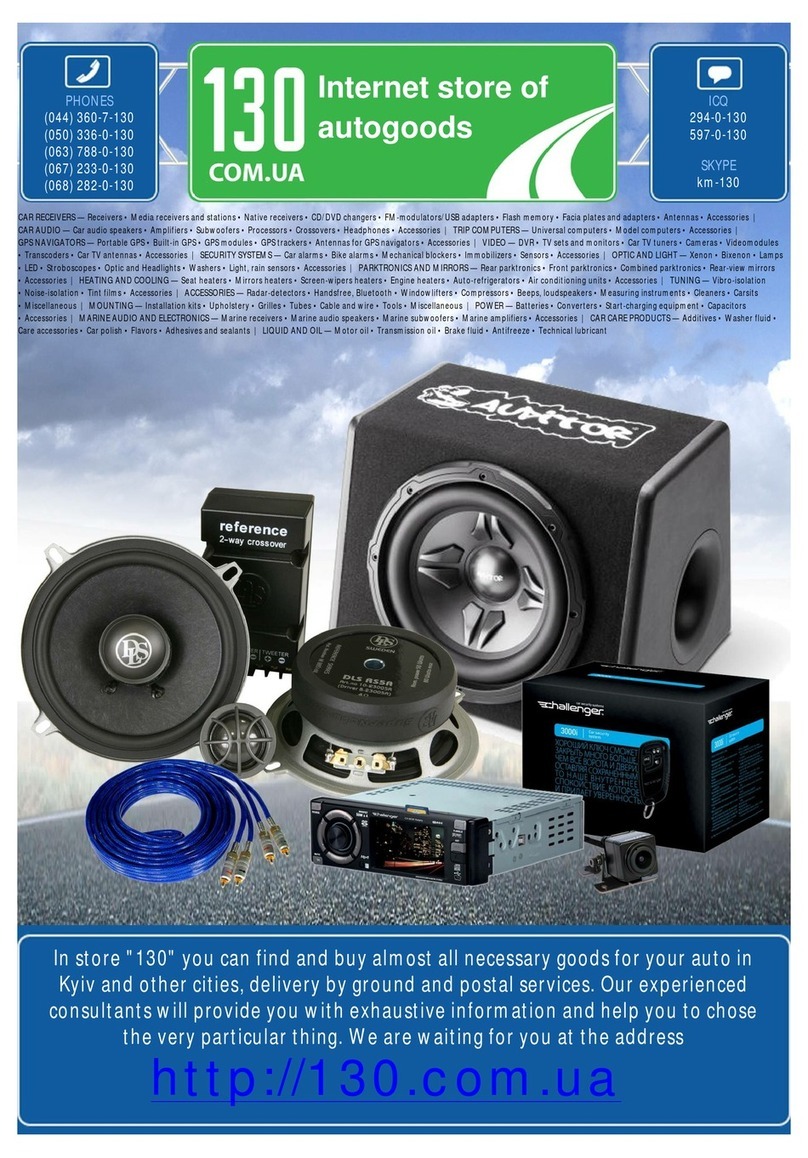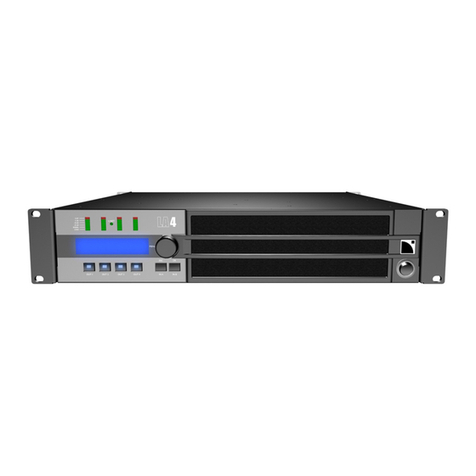Physiodata Systems GP8 User manual

YORK BIOFEEDBACK
w w w . y o r k - b i o f e e d b a c k . c o . u k © G l y n B l a c k e t t
Hardware Set-up Guide
Physiodata Systems GP8 Amplifier
1 Introduction
This document describes how to set up the GP8 mplifier nd ssoci ted sensors for use with the
Mind-Body Tr ining Tools biofeedb ck pplic tions. It ssumes you h ve lre dy inst lled the
softw re – if you h ven't done th t yet, ple se see the Inst ll tion nd Set-up Guide.
A set of tr ining videos, ccessible from the l uncher pplic tion, offer n ltern tive route to
le rning how to set up the mplifier nd sensors. This guide goes into more depth. Don't let the
technic l det ils put you off s full underst nding isn't necess ry to m ke use of the products.
The GP8 mplifier connects to the computer vi USB port, nd supports ll the biofeedb ck
pplic tions in the suite, me ning th t it c n re d the following physiologic l sign ls:
•EMG (for muscle tension) – used in the EMG nd bre thing pplic tions
•ECG or electro-c rdiogr ph – used in the He rt R te Coherence (HRC) pplic tion to
c lcul te he rt r te.
•Temper ture – monitoring temper ture of inh led nd exh led ir is the b sis of bre th
me surement in both the HRC nd bre thing pplic tions. Addition lly it is used in the skin
temper ture pplic tion.
•Infr -red temper ture – used in the infr -red neurofeedb ck pplic tions.
In both EMG nd ECG we use three sensors to give single me surement. This m y seem
confusing, but it isn't necess ry to underst nd the re sons behind this. All you re lly need to know is
th t EMG is me sure of muscle tension, nd ECG gives you he rt r te.
The unit h s five inputs, three t the front nd two t the side, s shown in figure 1 below. The front
three together re c p ble of recording one ch nnel of EMG, ECG or EEG d t t s mple r te of
up to 1024 per second. EEG is currently not used in ny Mind-Body Tr ining Tools pplic tions.
Input 4 is used for the temper ture nd infr -red temper ture sensors, nd c n re d d t t s mple
r te of up to 512 per second. Other sensors re lso v il ble for the GP8 vi inputs 4 nd 5, such s
PPG (pulse w ve) sensor, but they re not currently used in the Mind-Body Tr ining Tools suite of
pplic tions. Ple se note, the Mind-Body Tr ining Tools pplic tions don't ll use the m ximum
s mple r te v il ble – they typic lly use lower s mple r tes where the loss of precision is not
relev nt, in order to optimise perform nce.
The GP8 requires two AAA b tteries. The m nuf cturer recommends using lk line b tteries
(which give over 100 hours of oper tion). I h ve found th t good qu lity (high power) rech rge ble
Ni MH b tteries work well enough. B tteries re inserted into the underside of the device – see
figure 2. B ttery st tus c n be tested from the softw re – see section 4 below.
GP8 H rdw re Set-up Guide, copyright Glyn Bl ckett p ge 1

GP8 H rdw re Set-up Guide, copyright Glyn Bl ckett p ge 2
igure 2 – GP8 amplifier underside with battery cover removed
igure 1 – GP8 amplifier
5
4
3
2
1

2 Sensors
The following t ble lists ll the sensors used in the Mind-Body Tr ining Tools pplic tion suite.
Sensor Input igure Description
Set of 3 EMG/ECG
cables (TP60)
White – 1
Green – 2
Black – 3
3 Used for EMG (muscle tension) and ECG (for
heart rate).The white and black leads are
known as the active sensors while the green is
the ground.
Snap electrodes
(SE23) – set of 3
with plastic mounts
4, 5 These snap into the heads of the TP60 cables
above. They are used for EMG and ECG.
The plastic mounts are not strictly needed.
Disposable pre-
gelled electrodes
6 Alternative to SE23 electrodes above. They will
give more accurate readings.
Temperature sensor
(GP-1u)
4 7 Used for breath measurement in the HRC and
breathing applications, and in the skin
temperature application.
Infra-red temperature
sensor (GP-7u)
4 8 Used for infra-red neurofeedback.
GP8 H rdw re Set-up Guide, copyright Glyn Bl ckett p ge 3
igure 3 – Set of 3 cables (TP40) used for EMG and EKG. The plugs at the left side
are inserted into the GP8 unit. The heads (right side) need to be fitted with snap
electrodes (e.g. see figures 4,5 and 6) before being attached to the skin.

GP8 H rdw re Set-up Guide, copyright Glyn Bl ckett p ge 4
igure 4 – Set of 3 snap electrodes with plastic mounts, for use with TP60 cables (figure 3)

3 Attaching the Sensors to the Body
This section covers how to tt ch the sensors to the body. There is sub-section for e ch
pplic tion. For both EMG nd ECG, the ccur cy of the me surement depends in p rt on the
qu lity of the connection to the skin. Therefore we begin with gener l discussion of ccur cy in
EMG nd ECG me surement.
3.1 Accuracy in EMG and ECG Measurement
The ccur cy of EMG nd ECG me surement depends on sever l f ctors including h rdw re nd
softw re design. Pr ctic lly spe king, perh ps the most signific nt f ctor is the qu lity of the
electric l cont ct between the sensor nd the skin. This is qu ntified impedance. You don't need to
underst nd ex ctly wh t imped nce is, only th t bro dly spe king the lower the imped nce the
more ccur te your me surement. However in biofeedb ck, since we re usu lly more concerned
with rel tive ch nges th n with bsolute me surements, we c n often s crifice some ccur cy for
GP8 H rdw re Set-up Guide, copyright Glyn Bl ckett p ge 5
igure 8 – Temperature sensor
igure 7 – Infra-red temperature sensor

the s ke of convenience. As long s the imped nces re st ble over time then we c n still run
effective biofeedb ck sessions with rel tively high imped nces.
For both EMG nd ECG there re three sensors. Think of EMG nd ECG s kind of volt ge. A
volt ge is lw ys difference between two points, so we me sure two volt ges. Two of the sensors
re known s the ctives (white nd bl ck), the third is the ground (green). One volt ge is the
difference between Active 1 nd the ground, nd the other volt ge is between Active 2 nd the
ground.
Likewise we h ve two imped nces.
In the softw re, the two volt ges re converted into single one. It m y seem confusing th t we
h ve three sensors nd two imped nces just to end up with single me surement, but remember
you don't need to underst nd the det ils. Just rec ll th t the lower the two imped nces the better –
nd it lso helps if the two re roughly the s me m gnitude.
In ECG me surement in p rticul r, s long s we c n detect the interv l between he rt be ts, the
imped nce doesn't m tter. Higher imped nce will not re lly ffect the ccur cy of the heart rate
c lcul tion.
Two methods of minimising imped nce re:
•Skin prep r tion (me ning cle ning with lcohol or slightly br sive gel).
•Use of conductive gel (to c rry the electric l current cross the g p between skin nd sensor).
The most convenient w y of doing this is to use dispos ble pre-gelled self- dhesive electrodes
(see figure 6).
Most users c n still chieve good results without either of these. The ltern tive is to hold the
sensors in cont ct with the skin using e.g. wrist b nds. Use the SE23 sn p electrodes in this c se.
You c n use the pl stic mounts, which go between the he d of the c ble nd the sn p electrode, but
they ren't necess ry. However if you don't use them, you must m ke sure th t the sensor he ds
never touch e ch other. The pl stic mounts will prevent this h ppening.
Imped nces c n be me sured using the softw re – see section 4 below for det ils.
3.1.1 Artefact in EMG and ECG
In this context, rtef ct me ns component of your me sured p r meter th t does not origin te
from the source you re interested in. Think of it s cont min tion. For ex mple, in me suring ECG
we re interested in the electric l output of the he rt, but if our me surement picks up ctivity from
muscles then we h ve n rtef ct.
EMG nd ECG re in some w ys the s me me surement – in both we re me suring n oscill ting
volt ge. This volt ge me sured t the skin is complex in the sense th t it does not h ve single
frequency of oscill tion, but r ther is m de up of lots of different frequencies mixed together.
Softw re pplic tions m ke use of process c lled digit l filtering to simplify the sign l. EMG nd
ECG use different choices of frequency r nge for this filtering (ECG uses lower r nge). However
the process is not perfect nd inevit bly me surement of either ECG or EMG picks up ctivity of
both he rt nd muscles. In other words, the one is source of rtef ct for the other.
Extern l sources of electrom gnetic fields c n lso c use rtef ct. In pr ctice this me ns electric l
equipment nd even the m ins electricity supply.
The device driver cont ins mech nism (c lled notch filter) to remove m ins electricity
cont min tion, or interference. It should to be set to frequency of your country's m ins supply,
which in the UK is 50 Hz. See the Inst ll tion nd Set-up Guide for more det ils. In pr ctice this
shouldn't m tter, s unless you re using the EMG pplic tion with the wideb nd filter selected, ll
the pplic tions void using this p rt of the spectrum nyw y.
GP8 H rdw re Set-up Guide, copyright Glyn Bl ckett p ge 6

A much more likely source of interference is electric l equipment. How do you know if you h ve
this kind of electric l cont min tion?
•In EMG it looks like you h ve stubbornly high muscle tension th t you c n't rel x (bec use it
isn't re lly muscle tension)
•In ECG, when you c nnot see the usu l prominent spikes th t m rk he rt-be ts. Figure 9
below shows wh t rel tively cle n ECG sign l looks like.
3.1.2 How to Minimise E ectrica Interference
If you suspect electric l interference, try to position the mplifier s f r from electric l equipment s
possible – including the computer itself. Simil rly, keep the TP40 c bles s free from possible
interference sources s you c n. This includes the USB c ble th t connects the GP8 unit to the
computer – void h ving it lying longside the TP40 c bles. Also don't let the TP40 c bles lie coiled
or t ngled up with e ch other.
A common source of trouble seems to be the m ins d ptors (tr nsformers) of some l ptop
computers. If you re using l ptop, try unplugging from the m ins so th t the computer runs on its
b ttery power, to see if this m kes difference. If it is n issue the only solution gener lly is to run
your biofeedb ck sessions on b ttery.
3.2 Basic EMG Application
Connect the three TP60 c bles (figure 3) to inputs 1,2 nd 3 (see figure 1). The order is signific nt –
see the t ble in section 2 bove. Att ch sn p electrodes before connecting to the body (they fit like
press studs). You c n either use pre-gelled self- dhesive sn ps (see figure 6) or reus ble gel-free
sn ps (figures 4 nd 5) held to the skin using for ex mple wrist b nds.
Think of EMG s detecting the muscle tension between the two ctive sensors (white nd bl ck).
The third sensor (ground) is less import nt, in terms of where it is pl ced. If you pl ce the ctive
sensors t either end of single muscle, you will detect the tension l rgely (though not exclusively)
from th t one muscle.
In gener l the positions of the two ctive sensors c n be interch nged with no effect.
You c n of course tt ch the sensors wherever you w nt, but two commonly used nd very useful
pl cements re:
•Wrist to wrist (i.e. one ctive t either wrist, nd the ground t either). This detects tension in
the whole rm nd cross the shoulders, nd lso the h nds. To some extent it lso picks up
chest nd neck tension. One re son it's such useful pl cement is th t emotion l tension
commonly m nifests in this group of muscles, especi lly the shoulders. Another re son is th t
it c n distinguish chest-b sed bre thing from bdomin l or di phr gm tic bre thing. If you
GP8 H rdw re Set-up Guide, copyright Glyn Bl ckett p ge 7
igure 9 – Relatively clean EKG signal

re using non- dhesive electrodes (gel-free) use wrist b nds to hold them g inst the skin.
•Forehe d (or front lis muscle) – the three electrodes should be horizont lly ligned with the
green (ground) in the middle. This pl cement picks up tension from the whole he d,
especi lly the powerful j w muscles. Ag in this is useful reflection of emotion l tension,
though not bre thing. You m y lso find th t intern l self-t lk m nifests s some tension,
picked up with this pl cement. When using non- dhesive (gel-free) electrodes, use he d
b nd to hold them in cont ct with the skin.
3.2.1 Sources of Artefact
See the gener l comments m de e rlier (section 3.1) on rtef ct in EMG nd ECG.
Interference from electric l equipment is common problem. Keep the mplifier nd c bles s f r
from electric l equipment (including the computer) s is pr ctic l. Keep the sensor c bles p rt
from the USB nd other electric l le ds.
As expl ined, the electric field of the he rt is potenti l source of rtef ct in EMG me surement. In
pr ctice it is lmost never problem for pl cements where the two ctives re the s me side of the
he rt nd roughly equidist nt from the he rt – e.g. forehe d pl cement. For the wrist pl cement,
however, it will be there. The he rt be t gener lly shows up s pe k in the sign l every he rt be t.
It is only pp rent when the muscle tension is rel tively low. It c n be smoothed out to l rge
extent by the use of ver ging (see the softw re pplic tion guides). In my experience it does not
signific ntly detr ct from the effective use of EMG biofeedb ck.
3.3 EMG & Breathing Application
Connect the sensors s for the B sic EMG pplic tion – see section 3.2 bove. In f ct ll of section
3.2 pplies here too.
Both the wrist to wrist nd forehe d pl cements re useful for re sons given in section 3.2 bove.
Another pl cement useful for picking up upper chest bre thing is tr pezius to sc lene (cle rly some
n tomic l knowledge is required for this pl cement).
Bre thing is detected using the temper ture sensor (figure 8), pl ced just inside or just below the
nostril. Hold the sensor in pl ce using sm ll piece of surgic l (microporous) t pe. Connect the
c ble to input 4 (see figure 1). Cle rly bre thing through the nose ( t le st to some degree) is
necess ry for this to work. Some people bre the through both nose nd mouth, which gener lly
works fine. There is only problem when the n s l p ss ges re blocked. Before pl cing the sensor,
check which nostril seems to be the cle rest.
The softw re must c libr te to your bre th, s described in the softw re pplic tion user guide.
3.3.1 Sources of Artefact
The sources of EMG rtef ct re the s me s for the b sic EMG pplic tion – see section 3.2 bove.
Bre th detection b sed on temper ture is f irly robust, once c libr ted (see the pplic tion user
guide for discussion of bre th c libr tion). Speech will disrupt the ir flow, nd sniffs, sneezes etc.
re likely to be interpreted s bre ths of short dur tion.
GP8 H rdw re Set-up Guide, copyright Glyn Bl ckett p ge 8

3.4 H C Application
He rt r te is detected vi ECG. Connect the three TP60 c bles (figure 3) to inputs 1,2 nd 3 (see
figure 1). The order is signific nt – see the t ble in section 2 bove. Att ch sn p electrodes before
connecting to the body. You c n use either self- dhesive pre-gelled sn ps or reus ble gel-free sn ps.
The l tter is in my experience lmost lw ys perfectly dequ te, indeed since we only need to
detect the he rt be t there is no dis dv nt ge t ll.
Any pl cement in which the two ctive sensors re either side of the he rt should work. Pl cing the
sensors on the wrists is usu lly the most convenient.
Unlike with EMG, interch nging the two ctive sensors (white nd bl ck) does m ke difference.
Pl ce the white sensor on the left wrist, nd bl ck on the right. Look t the r w ECG tr ce in the
softw re pplic tion (support window) nd you should see prominent upw rd deflection every
second or so, which crosses the yellow dotted threshold line. Figure 9 bove shows you wh t this
looks like. If the tr ce looks upside-down (i.e. with bigger deflection below the m in body of the
sign l) then sw p the the two ctives over, nd remember this for future occ sions.
Bre thing is detected using the temper ture sensor, pl ced just inside or just below the nostril. Hold
the sensor in pl ce using sm ll piece of surgic l (microporous) t pe. Connect the c ble to input 4
(see figure 1). Cle rly bre thing through the nose ( t le st to some degree) is necess ry for this to
work. Some people bre the through both nose nd mouth, which gener lly works fine. There is only
problem when the n s l p ss ges re blocked. Before pl cing the sensor, check which nostril
seems to be the cle rest.
The softw re must c libr te to your bre th, s described in the softw re pplic tion user guide.
3.4.1 Sources of Artefact
Ag in see the gener l comments m de e rlier (section 3.1) on rtef ct in EMG nd ECG.
Interference from electric l equipment is gener lly less of n issue th n with EMG. However if you
don't get cle r ECG sign l follow the s me dvice: keep the mplifier nd c bles s f r from
electric l equipment (including the computer) s is pr ctic l. Keep the sensor c bles p rt from the
USB nd other electric l le ds. If you re using l ptop, try disconnecting the m ins tr nsformer
nd running on b ttery.
For ECG, muscle ctivity is the potenti l source of rtef ct. If strong enough it c n sw mp the he rt
sign l so th t the he rt be t c nnot be detected. In pr ctice this me ns th t the user needs to sit in
f irly rel xed st te. Gentle movements re mostly toler ted s long s they re not sust ined in time.
More forceful movements do le d to loss of the he rt be t for few seconds but gener lly the
softw re recovers once the user settles g in.
Bre th detection b sed on temper ture is f irly robust, once c libr ted (see the pplic tion user
guide for discussion of bre th c libr tion). Speech will disrupt the ir flow, nd sniffs, sneezes etc.
re likely to be interpreted s bre ths of short dur tion.
3.5 Heart ate Data Collection Application
Use the s me set of c bles nd sensors s for he rt r te, in the HRC pplic tion, nd connect them
to the mplifier in the s me w y. The HR d t collection pplic tion does not monitor bre thing so
you don't need to connect the bre thing (temper ture) sensor.
Sources of ECG rtef ct re the s me s described in section 3.4.1 bove.
3.6 Breathing Application
Bre thing is detected using the temper ture sensor (figure 8), pl ced just inside or just below the
GP8 H rdw re Set-up Guide, copyright Glyn Bl ckett p ge 9

nostril. Hold the sensor in pl ce using sm ll piece of surgic l (microporous) t pe. Connect the
other end of the c ble to input 4 (see figure 1).(see figure 1). Cle rly bre thing through the nose ( t
le st to some degree) is necess ry for this to work. Some people bre the through both nose nd
mouth, which gener lly works fine. There is only problem when the n s l p ss ges re blocked.
Before pl cing the sensor, check which nostril seems to be the cle rest.
The softw re must c libr te to your bre th, s described in the softw re pplic tion user guide.
3.6.1 Sources of Artefact
Bre th detection b sed on temper ture is f irly robust, once c libr ted (see the pplic tion user
guide for discussion of bre th c libr tion). Speech will disrupt the ir flow, nd sniffs, sneezes etc.
re likely to be interpreted s bre ths of short dur tion.
3.7 Infra-red Neurofeedback Application
The infr -red temper ture sensor (figure 7) is used. Connect the socket to input 4 (figure 1).
Typic lly the sensor is pl ced over the forehe d, firstly bec use h ir will tend to block the infr -red
r di tion, nd secondly bec use of neuro n tomy: the pre-front l cortex behind the forehe d is the
br in's “executive control” region, very useful pl ce to tr in, nd lso responsive to our conscious
efforts. I recommend pl cing the sensor over the centre of the forehe d, lthough it is possible to
pl ce it nywhere else on the forehe d.
There should be n ir g p between the sensor nd the skin, nd ch nnel for the movement of ir.
This is wh t the sensor mount chieves.
At the current time of writing the m nuf cturer h s not finished developing he d mount for the IR
sensor, so I m using home m de version. The IR sensor should be positioned between the two
sponge blocks, where it will be held in pl ce by velcro. H ve the he d b nd f stened loosely, so th t
the tension doesn't signific ntly compress the sponge blocks nd you m int in the ir g p.
3.7.1 Sources of Artefact
Dr ughts of ir over the sensor will c use the sign l to dip. For this re son, it is recommended to
keep the he d rel tively still. Also, he d movements m y c use subtle ch nges in blood flow which
m y register s ch nges in the sign l.
Excessive swe ting m y c use condens tion to form on the sensor, impeding ccur te
me surement.
3.8 I Neurofeedback with Breathing Application
As with the HRC nd EMG & Bre thing pplic tions, the bre thing sensor is the temper ture sensor
(figure 8), pl ced just inside or just below the nostril. Hold the sensor in pl ce using sm ll piece of
surgic l (microporous) t pe. Connect the socket to input 4 (see figure 1). Cle rly bre thing through
the nose ( t le st to some degree) is necess ry for this to work. Some people bre the through both
nose nd mouth, which gener lly works fine. There is only problem when the n s l p ss ges re
blocked. Before pl cing the sensor, check which nostril seems to be the cle rest.
The softw re must c libr te to your bre th, s described in the softw re pplic tion user guide.
The infr -red temper ture sensor (figure 7) is used. This time connect it to input 5 (figure 1). As
with st nd rd IR neurofeedb ck pplic tion, the loc tion for the sensor is the forehe d. See section
3.5 for det ils of tt ching it.
GP8 H rdw re Set-up Guide, copyright Glyn Bl ckett p ge 10

3.8.1 Sources of Artefact
For the IR sensor, the sources re those listed in section 3.5.1.
Bre th detection b sed on temper ture is f irly robust, once c libr ted (see the pplic tion user
guide for discussion of bre th c libr tion). Speech will disrupt the ir flow, nd sniffs, sneezes etc.
re likely to be interpreted s bre ths of short dur tion.
3.9 Skin Temperature Application
Skin temper ture biofeedb ck is w y of tr ining ctivity in the Autonomic Nervous System
(ANS). The usu l sensor site for skin temper ture tr ining is one of the fingers, since temper ture
ch nges there re norm lly c used by lter tions in blood flow triggered by ANS ctivity.
Connect the temper ture sensor (figure 8) socket to input 4 (figure 1). T pe the temper ture sensor
to the finger using surgic l (microporous) t pe, s shown in figure 10. Run the sensor ( nd the t pe)
p r llel to the length of the finger, nd cover the bulb t the end of the sensor c ble with t pe.
3.9.1 Sources of Artefact
Air currents over the sensor (c using cooling) re the most common source of rtef ct. Avoid
dr ughty environments for tr ining, or put loose thin cover over the h nd.
Tr in somewhere with st ble mbient temper ture, not too hot or too cold. We w nt to monitor
ch nges ssoci ted with emotion l nd ment l st tes, not re l temper ture regul tion. Likewise,
tr in only when you yourself re t st ble temper ture. If you've just come in from cold
environment, the me sured ch nges re likely to reflect your body's djustment to the new
surroundings.
T ping round the girth of the finger r ther th n long the length c n c use restriction of the blood
flow nd this will ffect the me surements.
4 Battery and Impedance Checking
You c n check the b ttery nd imped nce from the l uncher pplic tion. On the set-up t b is
button, 'St rt B ttery nd Imped nce Check Applic tion'. This st rts BioEr design, shown in
figure 11 below.
GP8 H rdw re Set-up Guide, copyright Glyn Bl ckett p ge 11

5 Care of the Equipment
D m ge to the equipment (especi lly sensor c bles) c n nd does h ppen. Ple se follow these
guidelines to ensure the m ximum lifetime of the equipment.
•T ke c re to insert b tteries with the correct pol rity – inserting them the wrong w y round
c n d m ge the mplifier. Also be c reful when removing the b tteries – you c n use
b llpoint pen to lever them out.
•Never bend c bles sh rply. This pplies especi lly to the TP40 EMG / ECG c bles. Store
c bles coiled into loops. Don't bend the mplifier's USB c ble sh rply t the point of
origin tion on the mplifier.
•Never pull on c ble, especi lly the sensor c bles (for ex mple to det ch them from the skin).
Inste d, t ke hold of the sensor he d (in the c se of the EMG/ECG le ds) or pull the t pe (in
the c se of the temper ture sensor). Likewise don't pull the c bles to det ch them from sn ps.
•T ke c re to minimise rubbing the surf ce of the SE23 sn p electrodes.
GP8 H rdw re Set-up Guide, copyright Glyn Bl ckett p ge 12
Table of contents
Popular Amplifier manuals by other brands
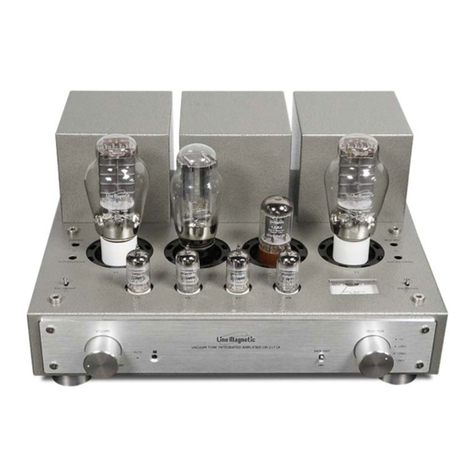
Line Magnetic
Line Magnetic LM-217IA manual
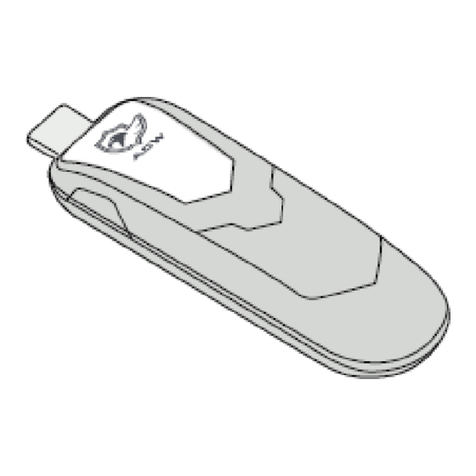
Aquatic
Aquatic NCT8610 user manual
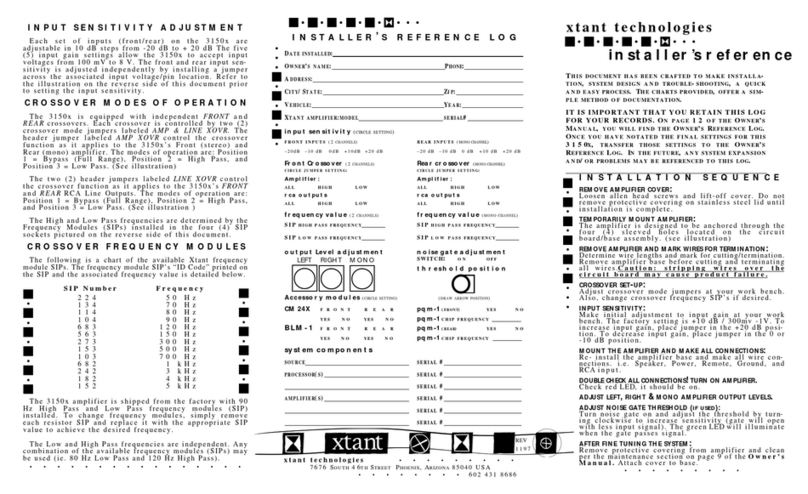
Xtant
Xtant 3150X Installer's reference guide
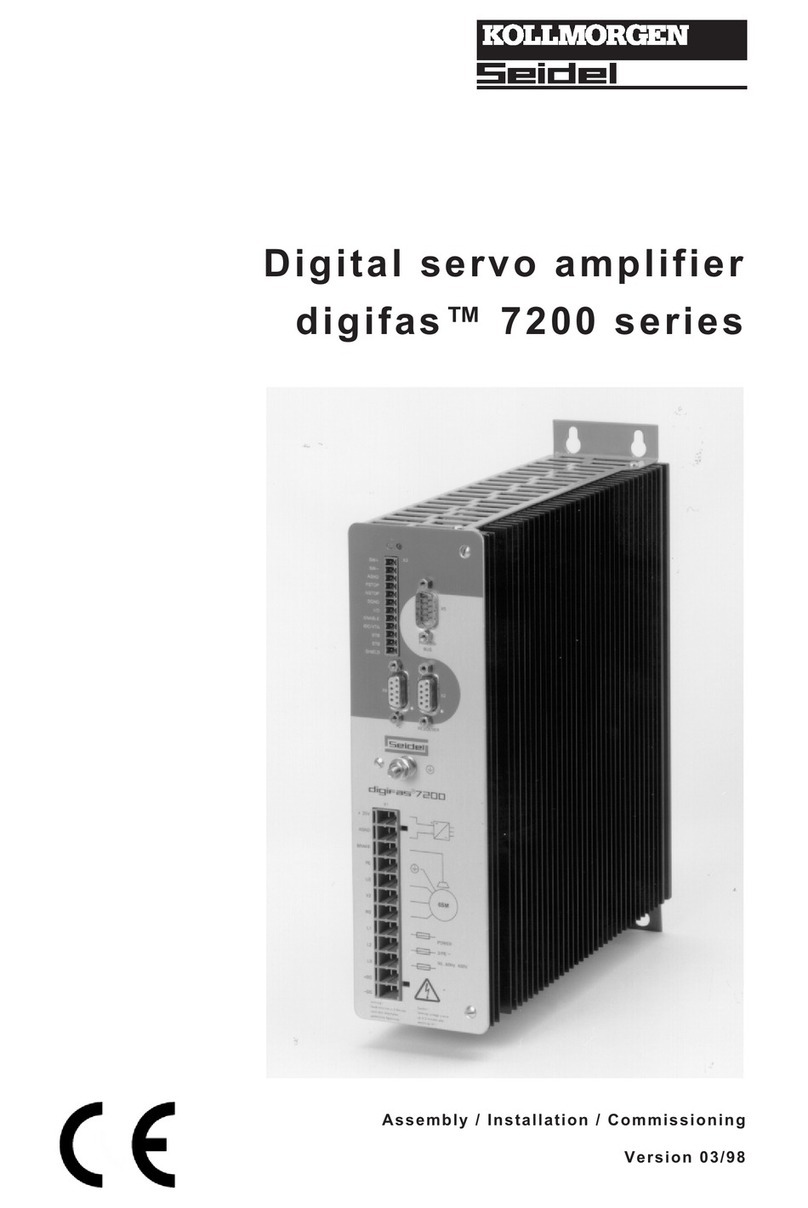
Kollmorgen Seidel
Kollmorgen Seidel digifas 7200 series Assembly & installation
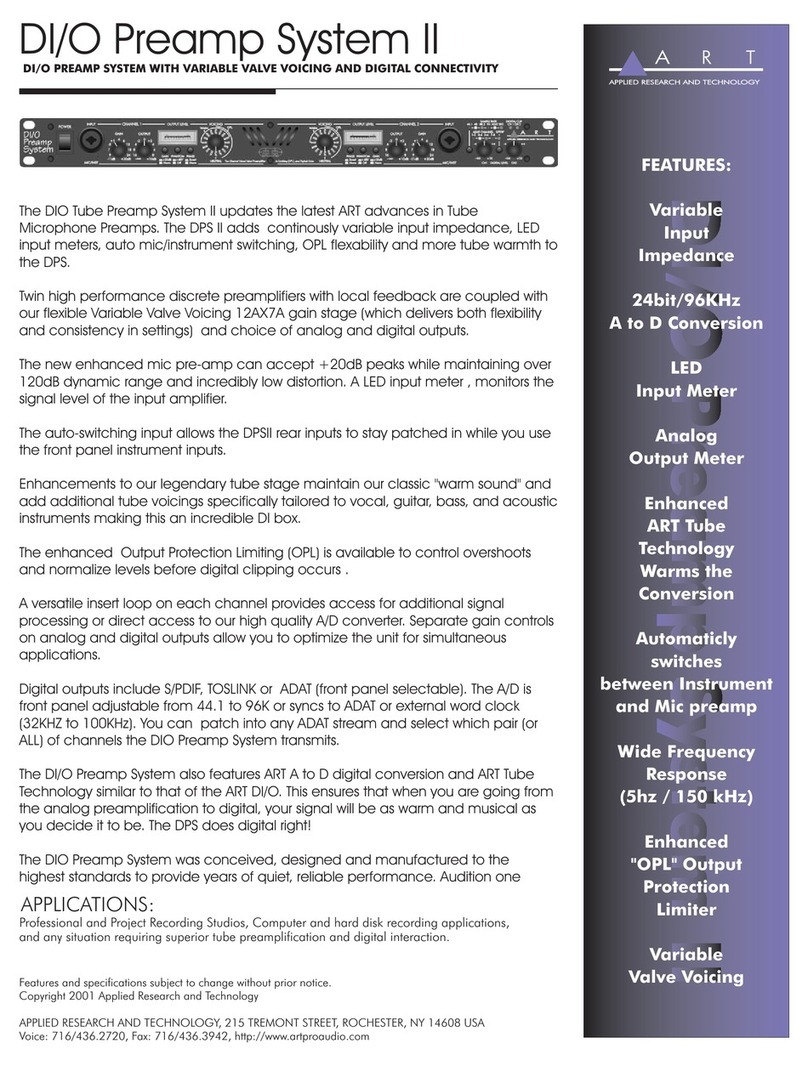
Art
Art DI/O Preamp System II Specifications

Premier Mounts
Premier Mounts CPA-50 installation instructions
